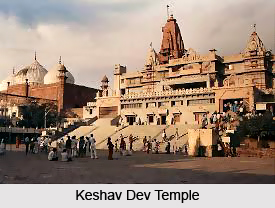 Keshava Deo Temple is one of the most important temples in Mathura. It has the mythological and historical significances. Every year, a large number of pilgrims from different parts of the world come and visit this place.
Keshava Deo Temple is one of the most important temples in Mathura. It has the mythological and historical significances. Every year, a large number of pilgrims from different parts of the world come and visit this place.
Keshava Deo Temple is also known as Krishna Janmasthan is a temple located in Mathura (Uttar Pardesh). This temple is known as one of the most sacred of Hindu sites as it is birthplace of Lord Krishna.
Keshava Deo Temple is considered as the birthplace of Lord Krishna. This temple still carries the local touch and feel of the several other temples in the twin towns of Mathura and Vrindavan.
Early History of Keshava Deo Temple
Early History says that the first temple here was constructed almost 5,000 years ago by Vajranabha, the great-grandson of Lord Krishna. The next big temple was constructed here during the time of the Gupta Emperor Chandragupta II around 400 AD.
Medieval History of Keshava Deo Temple
The second temple at the Keshava Deo Temple came up during the rule of Chandragupta Vikramaditya. It was destroyed by Mahmud of Ghazni in the year 1017. In Katra Keshavdeva, they found an inscription on a stone slab which speaks of the third temple, built by Jajja in Vikrama Samvat 1207, which is 1150 in the Georgian Calender during the rule of Vijaypal Deva. It is said Chaitanya visited the same temple when he came to Mathura before its destruction by the forces of Sikandar Lodhi in the 16th century. The fourth temple of Keshava Deo Temple by the King of Orchha came up after the destruction of the magnificent temple which was built by Guptas. The fourth temple of Keshava Deo Temple was built by Veer Singh Dev Bundela of Orchha when Jahangir was on the Mughal throne. Later the last Mughal Emperor, Aurangazeb ordered the destruction of the temple in the year 1669. There he built an Idgah that was constructed over a part of the raised plinth of the Keshava Deo Temple.
Modern History of Keshava Deo Temple
Modern History of Keshava Deo Temple traces from the decline of Mughal rule. The area came under direct rule of British India in the first phase of 17th century. In the year 1815 the British East India Company auctioned the area of Katra Keshavadeva Temple, which was purchased by the then Raja Patnimal of Varanasi. Although, the Raja of Benares (Varanasi) wanted to build a temple there, but his wish remained unfulfilled and the family had fight several legal battle for ownership of land with Muslim community of Mathura, in which, the court finally ordered that the land belongs to present heirs of Raja of Benaras (Varanasi). In 1944, Madan Mohan Malviya was distressed at plight of the site and arranged for purchase of land from Raja Krishna Das of Benaras, who sold the land only at cost of Rs. 13,000 recovering just the cost of fighting court battles.
Then Jugal Kishore Birla of Birla group decided to take the leading role to fulfil the wishes of Madan Mohan Malviya and formed a private trust in 1951 to which the rights of land were later transferred.
Jaidayal Dalmia of Dalmia Group was another leading personality who took untiring efforts and the temple was finally constructed over the site. The trust which runs Keshava Deo Temple has a glorious list of Trustees besides Birla family and Dalmia family members like Ganesh Vasudev Mavalankar, Anantashayanam Iyengar, Swami Akhandananda Saraswati, Swami Vamdevji Maharaj. The present head of temple is Mahant Nrityagopal Das. The construction of Keshava Deo Temple was completed in 1965.
Next to Keshava Deo Temple, within the complex is a small room that looks like a prison cell, where it is said that Lord Krishna was born.
The excavation of Keshava Deo Temple began in 1953 under the chairmanship of Swami Akhandanada, when the volunteers started the excavation continued for several decades later under supervision of Babulal Bajaj and Phool Chand Khandelwal, till the prison complex was completed in 1982.











